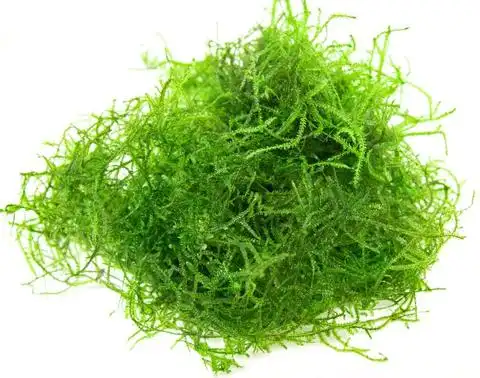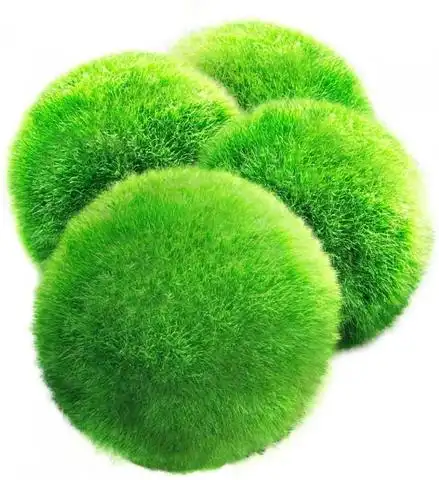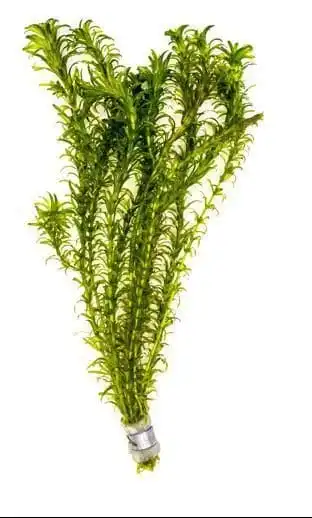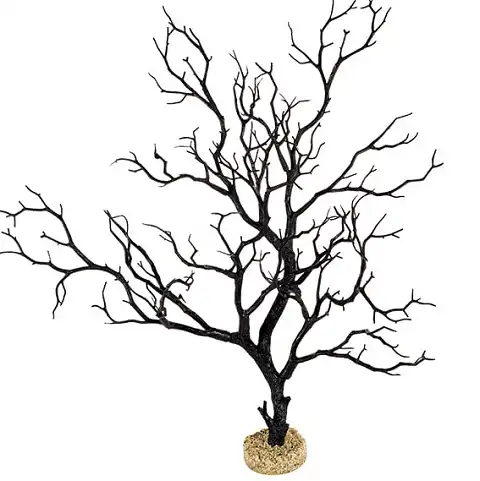Thank you for visiting! By the way… any links on this page that lead to products on Amazon and other stores/partners are affiliate links Aquarium Store Depot earns a commission if you make a purchase.
Are you thinking of adding a few species of aquarium plants to your goldfish tank? Adding live plants to a goldfish aquarium isn’t the easiest thing to do. These fish have a tendency to eat and destroy any plant in their vicinity. Fortunately, there are a few living greens that can survive them.
In this article, we will discuss everything you need to know to keep plants in your goldfish tank. I’ll also go over the 7 best plants for goldfish to eliminate the guesswork. Here’s how to get started.
The Challenge
Keeping aquarium plants in your goldfish tank can be quite challenging. Goldfish are generally very destructive towards most aquatic plants. If you still want to try your luck, you’ll need to consider the following points.
Temperature
Goldfish need the water temperature to be in the range of 68 to 74° Fahrenheit (20-23°C). It might be a bit challenging to find plants that will tolerate this coldwater fish environment. Tropical plants that require heaters may struggle quite a bit and grow very slowly under these conditions.
If you want to keep aquarium plants in your goldfish tank, it’s best to select plants that will tolerate or even prefer lower water temperatures. The perfect plants for goldfish are those that also grow quite quickly in low temperatures. Goldfish have a tendency to uproot and destroy live plants, so quick recovery is a preferred quality.
Plant Placement
It’s very important to think of plant placement. Goldfish have this nasty habit to dig up plants that require substrate. It’s best to avoid any of these heavy root feeders that require the substrate to grow.
If you want growing plants in your aquarium, try finding those that will thrive while floating or that prefers to root themselves on ornaments like driftwood. There are multiple varieties of aquarium plants that do just that.
High Nutrient Loads
Another thing to keep in mind is the high nutrient load of the water. Goldfish are large and extremely messy fish. They produce a lot of fish waste that leads to large amounts of nitrates in the water. Live plants will help to manage the high nutrient load of the water, but some might grow completely out of control.
The trick is to find the right plants for your goldfish tank. These will be plants that can grow without being rooted in the substrate and that prefer lots of nutrients, but won’t explode and take over. Generally, they will also be fast-growing plants, but you should be able to control them.
While doing your research, make sure to check the size of the mature plant, how fast it grows, and how well it will absorb nitrates. The more nitrates it can absorb from the aquarium water in a small amount of time, the better.
They Will Eat Most Plants
Goldfish are nuisances in a planted aquarium. They are very destructive and will quickly destroy sensitive species of plants, especially those rooted in the substrate. The best plants for goldfish aquariums are those that are hardy or unpalatable to these fish. If you want to see a visual example of a planted goldfish tank, check out an example below by FlameGourami.
A tough plant will be able to handle some mutilation and still manage to recover where more sensitive plants will simply perish. If you can’t find a plant your goldfish will leave alone, at least choose one that can handle the destruction and grow stronger because of it.
Many goldfish keepers opt to go for fake aquarium plants. These plants won’t be eaten by the goldfish, but they also don’t benefit the tank except for maybe looking nice. Some even grow terrestrial plants like peace lilies to make up for not having fully aquatic plants in the tank.
Keep in mind that peace lilies can be poisonous if eaten by your goldfish, so make sure there are other plants or lots of food for your fish to nip at instead.
Another terrestrial plant you can try is the pothos plant. Pothos plants will improve the water quality in your goldfish tank, but like peace lilies, should never be fully submerged. This plant cannot survive underwater. Allow the root system to dangle in the water while keeping the rest of the plant dry.
The root system of terrestrial plants offers hiding spots for most fish and is sometimes better at keeping the water parameters stable than most plants that grow submerged are. Keep them in mind as a backup if other aquarium plants just can’t keep up with the amount of waste your fish produce.
The 7 Best Plants For Goldfish
Let’s go into detail of the 7 plants I am recommending for goldfish. For visual learners, I have my video below for reference. My blog content has more details so keeping. Make sure to subscribe to my YouTube channel if you like the content.
1. Java Fern
Editor's Choice
Hardy, easy to care for, and requires only basic lighting to grow. This is the perfect aquarium plant for beginners!
- Scientific Name: Microsorum pteropus
- Skill Level: Beginner
- Size: 13.5 inches (34.3cm)
- Lighting: Low to high (40-200PAR)
- Tank Placement: Mid to background
- Growth Rate: Slow to moderate
- CO2 Requirement: Low
Java fern is a very hardy plant that grows quite easily without any expensive aquarium equipment. They do just fine in low-light environments without any added carbon dioxide. They are also excellent additions to goldfish tanks since these fish won’t bother nipping at the hard, fibrous leaves.
Java fern plants also don’t appreciate being planted in the substrate. Rather attach them to ornaments or other decorations with some fishing line and watch them thrive. This ability to grow outside the substrate means your java fern won’t get dug up and you can even keep a bare bottom tank if you like.
2. Java Moss
A great beginner plant that will do well in low light. Attaches well to driftwood and rocks
- Scientific Name: Taxiphyllum barbieri
- Skill Level: Beginner
- Size: 3-10 inches (7.6-25.4cm)
- Lighting: Low to high (40-200PAR)
- Tank Placement: Foreground to midground (Good carpeting plant)
- Growth Rate: Slow to moderate
- CO2 Requirement: Low to medium, recommended for increased growth rate
Java moss is an interesting aquarium plant that doesn’t have roots. Instead, this plant has sticky ends called rhizoids that they use to stick to just about any surface. For this reason, java moss is very versatile and can be used anywhere in a fish tank. It is most often used as a carpeting plant, however.
Java moss, like java fern and anubias, doesn’t require any special equipment. They do perfectly fine in a tank with low lighting. More light will make the strands more compact, however.
Goldfish will mess with this plant, but generally, it can outgrow the damage. Some fish keepers say goldfish avoid it, but this isn’t really true. Java moss just recovers very quickly so fish keepers might not notice any damage to the moss.
3. Anubias
- Scientific Name: Anubias species
- Skill Level: Beginner
- Size: 4-15.7 inches (10-40cm) depending on species
- Lighting: Low to high (40-200PAR) depending on species
- Tank Placement: Foreground to background depending on species
- Growth Rate: Slow
- CO2 Requirement: Low
Anubias plants are ideal for goldfish tanks since they prefer to grow outside of the substrate. Their root systems are adapted to take nutrients directly from the water column and will rot if buried in the substrate. It’s best to tie them to other ornaments like rocks and driftwood to keep them growing.
This plant is extremely hardy, but it grows slowly. This makes it vulnerable to algae growth on the leaves. Fortunately, the tough, rubbery leaves aren’t favored by goldfish.
Anubias is a rhizome plant. This is the structure where the roots and leaves grow from. It’s very important to keep the rhizome exposed to the water column at all times to avoid problems such as rot and eventually death.
Anubias plants, like java fern and moss, are great for low-tech setups due to their preference for low light conditions. When combined with other plants, make sure they all have the same light requirements. Anubias plants will do well in medium lighting as well but will suffer in high light conditions.
4. Marimo Moss Ball
Budget Option
A cheap and easy to care for aquarium plant. Thrives in low light and very low maintenance
- Scientific Name: Aegagropila linnaei
- Skill Level: Beginner
- Size: 2.3-12 inches (5.8-30.5cm)
- Lighting: Low to moderate (40-125PAR)
- Tank Placement: Foreground to midground
- Growth Rate: Very Slow
- CO2 Requirement: Low
The marimo moss ball is actually algae and not a true plant. These moss balls are super easy to care for, prefer low light, and are generally left alone by most goldfish. Some goldfish may become curious and try to eat it, however.
Despite being a very slow grower, this ball of algae will help to keep your goldfish tank clean. It is really good at removing nitrates from the water and harbors a host of beneficial bacteria. Moss balls also help to prevent other less desirable algae from growing. This makes it ideal in tanks that contain slow growers like anubias and java fern.
Rotate your moss balls to keep them round and just forget about them for a while. Once in a while during a water change, simply rinse the ball to remove any fish waste or other debris that might have gotten stuck in the fibers.
5. Crinum calamistratum (African Onion Plant)
A bulb plant that does well against plant eaters due to its odd shape and hard leaves
- Scientific Name: Crinum calamistratum
- Skill Level: Beginner to intermediate
- Size: 36-48 inches (91.4-122 cm)
- Lighting: Moderate to high (100-200PAR)
- Tank Placement: Background
- Growth Rate: Slow
- CO2 Requirement: Low
Crinum calamistratum, commonly known as the African onion plant, is a bulb that can grow fully submerged in fresh or brackish water. It is most often used as a background plant in the aquarium hobby. This plant prefers moderate to high light to grow optimally in an aquarium.
The onion plant works in goldfish tanks since the leaves are hard and oddly shaped which makes it more difficult to damage than most other aquatic plants. If you’re considering new plants for your goldfish tank, this one can definitely be added to the list.
Keep in mind that Crinum calamistratum aren’t tiny plants. They can take up quite a bit of space in a fish tank. For this reason, avoid planting them in nano aquariums. Some goldfish keepers find that keeping this plant in a pot or vase with root tabs instead of rooted in the substrate is more convenient. Goldfish tend to uproot plants quite frequently if planted in the substrate.
6. Water Sprite
Readily available and easy to grow. This fast growing plant will soak up nutrients and thrive in low light
- Scientific Name: Ceratopteris thalictroides
- Skill Level: Beginner to intermediate
- Size: 6-11.8 inches (15-30cm)
- Lighting: Moderate to high (100-200PAR)
- Tank Placement: Midground, background, or floating
- Growth Rate: Fast
- CO2 Requirement: Low, recommended for improved growth rate
Water sprite is a beautiful plant that can be grown either in the middle of your tank, in the back, or left floating. When rooted in the background of your tank, you can leave it to grow out of the water. As floating plants, water sprite will grow faster than the rooted version. This is because of the high light exposure at the top of the tank.
Water sprite is one of the best aquatic plants for consuming excess nutrients in the water. This makes it one of the best plants for goldfish tanks. With high light exposure, this plant should grow quite rapidly. You might need to use some CO2 if the growth rate isn’t what you want it to be.
7. Elodea (Anacharis)
Excellent as a food source and sucks up nutrients in an aquarium. One of the easiest freshwater plants to care for
- Scientific Name: Elodea species
- Skill Level: Beginner
- Size: 4 – 36 inches (10.2 – 91.4cm) depending on species
- Lighting: Moderate to very high (100-250PAR)
- Tank Placement: Background or floating
- Growth Rate: Very fast
- CO2 Requirement: Low to high, will improve growth rate
Elodea is a very popular stem plant in goldfish tanks. There’s no need to try and prevent goldfish from eating it, this fast-growing plant can usually keep up with the demand.
This plant isn’t just one species, however, the word ‘elodea’ refers to many plants. While choosing plants from this group, you will need to keep in mind the size of your goldfish aquarium. Some Elodea plants can get very big and will take over quickly.
Elodea can be placed in the background of your tank or you can use them as floating plants. If grown planted, these aquarium plants will grow slower than the floating versions. The reason for this is that more of the plant will be exposed to light while floating.
Live Plant Alternatives For Tanks
Aren’t willing to maintain a live plant or two in your goldfish tank? Consider the following decorations instead.
Fake Plants
If you can’t find any goldfish plants that can keep up with your ferocious eaters, consider getting a fake plant or two. Fake aquatic foliage is an excellent alternative to living greens. They don’t need any special care like aquarium fertilizers and specialized planted aquarium lights to look good. Most goldfish won’t even know the difference.
Unfortunately, care must be taken when selecting the fake plant you like. Some fake plant makes are made from plastic that has sharp edges. This can be a problem if you have a clumsy swimmer like a fancy goldfish. It’s best to stick to silk plants where possible. These are made of a soft material that won’t damage your fish’s fins. The product below from Marina is a great silk plant product.
Silk plants that are designed to be gentle on fish with fancy fins like Bettas and Fancy Goldfish
If the plant isn’t real, it also won’t contribute anything besides looks and shelter to the tank. A real plant will at least absorb some nutrients out of the water column. This keeps the water parameters stable for longer. Without the real thing, you will need to do more tank maintenance since goldfish are very messy critters.
Bare Tanks
Some goldfish keepers opt to go for a bare-bottom tank. These tanks are easier to clean and maintain. Just because you have a bare tank, however, doesn’t mean you can’t have any live plants.
If you have other aquarium ornaments in your tank, you can still grow an aquarium plant or two on it. You will have to pick a plant that can live outside the substrate to survive in this goldfish aquarium.
Fortunately, there are a few goldfish plants that will get the job done. An aquarium plant like anubias for instance prefers to grow on other ornaments instead of in substrate.
Other Decor Options
If you don’t like the look of fake greens, consider creating a tank with only ornaments in it. You can choose something like driftwood, stacked rocks, or even ceramic decorations to decorate your tank. A great artifical driftwood to use is offer by Current USA.
This is an artificial Manzanita branch that is designed by aquascapers. A worry free way of creating a natural looking aquascape!
Driftwood comes in all shapes and sizes and can look great used on its own. It can also be used to create some hiding spots for your fish.
Rocks can be stacked to create caves and tunnels for your fish to swim through. These can serve as endless entertainment and cant be destroyed by your overly curious goldfish.
Ceramic decorations come in many shapes, colors, designs, and sizes. You will need to decide what you want to do before buying any of these decorations. If you’re creating a tank for kids, you might want to add SpongeBob or another child-themed decoration to the tank to make it more exciting.
Fake VS Real Plants – What Is Better?
Goldfish like an aquarium plant or two in their tanks. They use these to hide under and in the case of live plants, they’ll also snack on them. These fish are very curious creatures. You will notice them investigating any new plants added to the tank, no matter if they are fake or real.
Now you may be wondering if live or fake plants are better for goldfish. Let’s take a look.
Living Plants
Living plants are great for goldfish tanks if you choose the correct plants for the job. These plants offer a range of benefits to the tank. Here are the pros and cons of keeping a living plant in a goldfish tank.
Pros
- Removes nitrates from the water
- Provides oxygen to the fish
- Source of entertainment for goldfish
- Contribute to a healthy goldfish diet
- Looks great in the tank
- Offers a place to hide in
- Offers a place to lay eggs in
Cons
- A plant that requires substrate will be uprooted frequently
- Goldfish have a nasty habit of eating just about anything green in their tanks
- A slow-growing plant may be destroyed and killed
Fake Plants
Fake plants are a good option for very destructive goldfish. They can also look good if care is taken when choosing the right designs. Here are the pros and cons of using plant imitations in your tank.
Pros
- Looks great
- Goldfish can’t destroy them
- Offers shelter for your fish
- Offers a place to lay eggs in
Cons
- Offers a great surface for algae to grow on
- There are no benefits to the tank besides contributing to the aesthetics
- Fancy goldfish’s fins may get damaged by the sharp plastic edges
FAQS
Are real plants good for them?
Live plants are great for goldfish. These fish love to nibble on anything green, therefore any plants used must be goldfish safe. The best goldfish plants are generally those that grow really fast or aren’t very tasty.
Do they need plants in their tank?
No, but live plants will definitely help to improve the water quality in your goldfish aquarium. They will remove some of the nitrates from the water while releasing oxygen for your fish to use. Fake plants look great, but they don’t contribute in any other way to the tank.
Which plants are beneficial?
Any live plants will benefit your tank but the best are those that grow very quickly. These include plants such as Java fern, Java moss, Anubias, Onion plant, Elodia, Water sprite, and Cryptocorynes.
Final Thoughts
Goldfish keeping isn’t the easiest thing when it comes to keeping your aquarium foliage alive. These fish are voracious eaters that will nibble on just about anything. Fortunately, as you now know, there is a plant or two that can survive them.
Now all you have to do is select your favorite, buy them and introduce them into your tank. Most importantly, remember to have fun.
Happy fish keeping!
- About the Author
- Latest Posts
I’m thrilled that you found Aquarium Store Depot! Here you’ll find information on fish, aquariums, and all things aquatics related. I’m a hobbyist (being doing this since I was 11) and here to help other hobbyists thrive with their aquariums! I adhere to a high quality Editorial Process and Review products with real life field usage and practical analysis.














Like your site. I have a tip for those with any type of goldfish and frustration of them eating your live plants. I have BIG tanks and I LOVE to use the water sprite in my tanks, and to help keep it safe, I use plastic trays. The cheap kind you can get at the dollar store that are like a basket, the bottom is solid but the sides have all the holes in them. They float perfectly at the top of the tank. The water sprite will eventually grow out over the sides or even through the holes. I just trim it back to inside the basket and drop the trimmings into the water. The fish will either eat them or they keep growing. It’s a win win. Make sure you check the baskets before putting them in the tank for any sharp points, I use a finger nail file to file any down. Hope this helps.